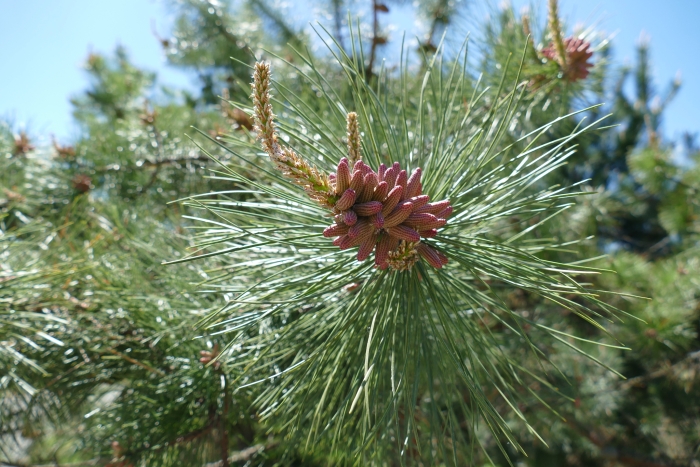Pitch Pine
(Pinus rigida)
Pitch Pine (Pinus rigida)
/
/

© KB DiAngelo
CC BY-SA 4.0
Image By:
© KB DiAngelo
Recorded By:
Copyright:
CC BY-SA 4.0
Copyright Notice:
Photo by: © KB DiAngelo | License Type: CC BY-SA 4.0 | License URL: http://creativecommons.org/licenses/by-sa/4.0/ | Uploader: kaybi | Publisher: iNaturalist |
















Estimated Native Range
Summary
Pinus rigida, commonly known as Pitch Pine, is a deciduous conifer native to the sandy plains, hills, and rocky ridges of eastern North America, ranging from Maine to Georgia and extending west to Kentucky. This tree is particularly adapted to fire-prone habitats, where it plays a crucial ecological role in regeneration and maintaining the health of pine barrens and other fire-dependent ecosystems. It typically grows to a height of 20-98 feet (6-30 meters) with a variable width, often featuring twisted branches and thick, plate-like bark that helps protect it from fire damage.
Pitch Pine is valued for its high regenerative ability, with the capacity to resprout needles and branches following damage. Its cones are serotinous, opening to release seeds in response to the heat from fires. The tree’s rugged appearance and ability to thrive in poor, acidic soils make it suitable for reclamation projects and naturalistic plantings. It is also used ornamentally in larger landscapes where its unique form can be appreciated. In cultivation, Pitch Pine prefers full sun and is tolerant of a range of soil types, including sandy and rocky soils with poor fertility. It requires minimal maintenance once established and is relatively free of serious pests and diseases. However, it is not commonly used in urban settings due to its irregular shape and size.CC BY-SA 4.0
Pitch Pine is valued for its high regenerative ability, with the capacity to resprout needles and branches following damage. Its cones are serotinous, opening to release seeds in response to the heat from fires. The tree’s rugged appearance and ability to thrive in poor, acidic soils make it suitable for reclamation projects and naturalistic plantings. It is also used ornamentally in larger landscapes where its unique form can be appreciated. In cultivation, Pitch Pine prefers full sun and is tolerant of a range of soil types, including sandy and rocky soils with poor fertility. It requires minimal maintenance once established and is relatively free of serious pests and diseases. However, it is not commonly used in urban settings due to its irregular shape and size.CC BY-SA 4.0
Plant Description
- Plant Type: Tree
- Height: 40-60 feet
- Width: 30-50 feet
- Growth Rate: Rapid, Moderate
- Flower Color: N/A
- Flowering Season: Non-Flowering
- Leaf Retention: Evergreen
Growth Requirements
- Sun: Full Sun, Part Shade
- Water: Low, Medium
- Drainage: Fast, Medium
Common Uses
Bird Garden, Drought Tolerant, Low Maintenance
Natural Habitat
Sandy plains, hills, and rocky ridges in fire-prone habitats
Other Names
Common Names: Hard Pine , Northern Pitch Pine , Torch Pine
Scientific Names: Pinus rigida , Pinus fraseri , Pinus loddigesii , Pinus rigida f. globosa , Pinus rigida f. rigida , Pinus rigida subsp. typica , Pinus rigida var. rigida , Pinus taeda var. rigida
GBIF Accepted Name: